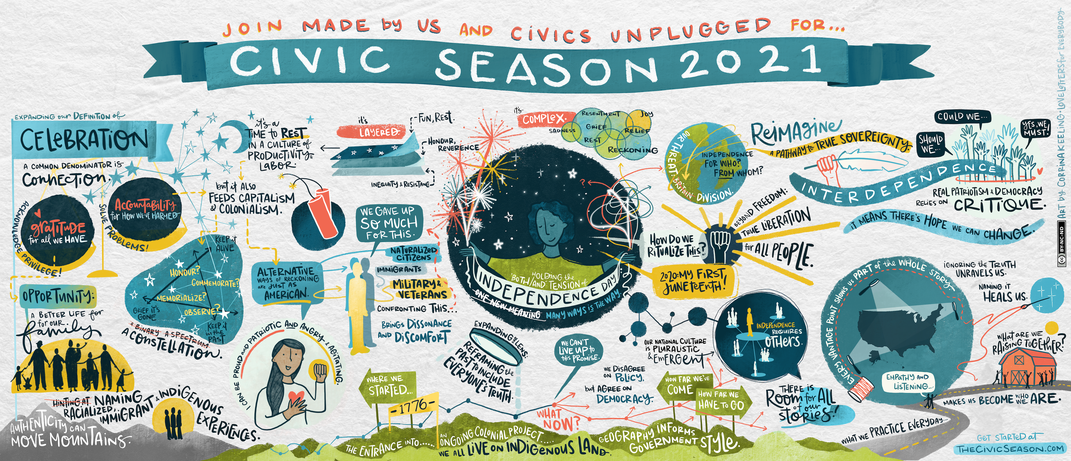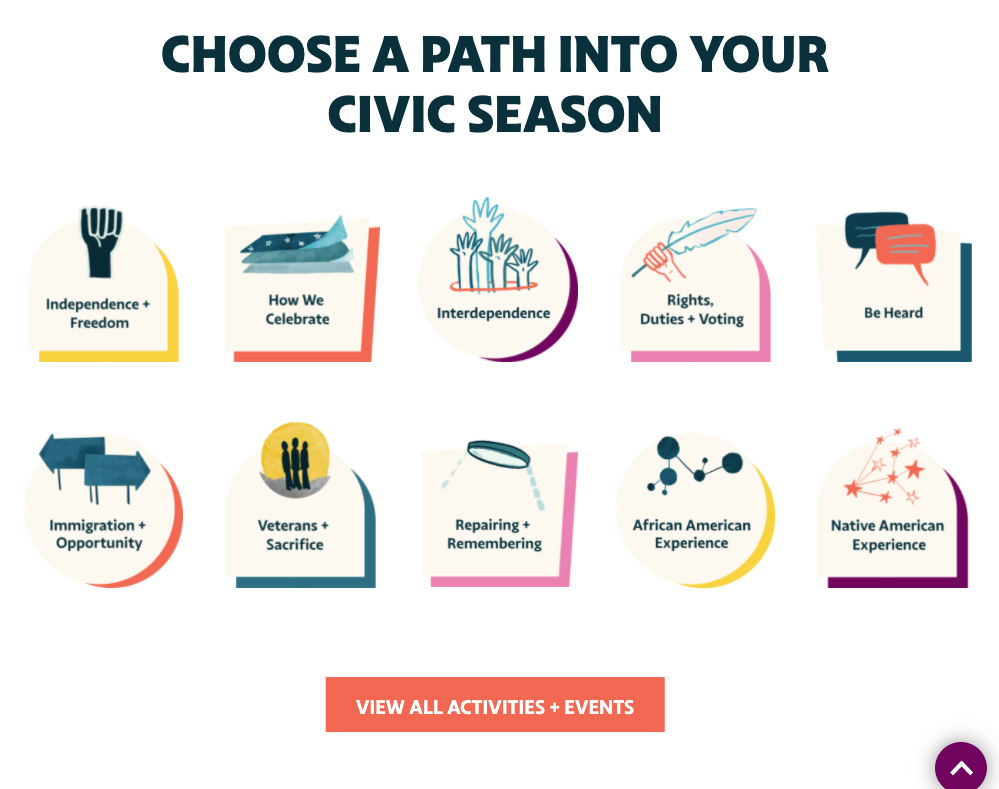A New Summer Tradition, a Three-Week ‘Civic Season,’ Asks Americans to Reflect on the Past and Future
Museums are inviting Americans to embrace the national story from its sins to its successes as a stepping stone towards a better future
/https://tf-cmsv2-smithsonianmag-media.s3.amazonaws.com/filer/5d/55/5d551cd7-31de-4323-b9c0-7292e48499a2/family-viewing-ssb-in-new-gallery.jpg)
In a dimly lit gallery at the National Museum of American History resides one of the Smithsonian’s marquee artifacts, the Star-Spangled Banner. To protect the 30-foot by 34-foot, 200-year-old American flag, visitors may not take photographs and the chamber is pressurized and equipped with 24-hour temperature and humidity sensors. This much-loved relic flew over Baltimore’s Fort McHenry to celebrate the end of the 25-hour British siege on September 13, 1814. Its appearance that morning, as the British ships fled the harbor, would inspire Francis Scott Key—a lawyer and slaveholder—to scribble the lyrics that would later become the national anthem. The gigantic banner is an impressive sight for the millions of annual museum visitors, but it’s only one exhibition in a museum filled with other artifacts that impart the rich, complex narrative of the American story.
And that full history of the country—and how it might inform what citizens want for the future—is the focus of a new national tradition in the making. Civic Season, a three-week period that stretches from Flag Day on June 14 through the Fourth of July, and includes Juneteenth and Pride Month, is a new initiative arising from a broad coalition of museums and non-profit organizations. The project aims to ask Americans, and young people in particular, to stretch the usual bounds of the red-white-and-blue festivities to include a new mission of reflection and civic engagement.
Through online resources as well as in-person exhibitions and events nationwide, the Civic Season offers “a chance to look back at this full story of how we got here, all the people and movements and moments that shaped the country that we now inhabit,” says the museum’s Caroline Klibanoff, who is the managing director of the civics-meets-history coalition Made by Us. “It reminds us that going forward, we are a part of that continuum. What we do today really matters to shape the next chapter.”
Spearheaded by Made by Us along with Civics Unplugged, the project is focused on 18- to 30-year-olds—a demographic museums often struggle to connect with—and helping them activate in the democratic process. This age range also coincides with when young people first wield civic power through voting.
“We started to pick up on a sentiment among young people, that they really had a lot of conflicted feelings around July 4th as just a wholesale celebration of the country,” says Klibanoff. “We heard an eagerness to do more with that holiday to lean into the history and lean into the opportunities for civic engagement.” So, out of this need, Civic Season was born.

Civic Season is meant to be activity-based; its organizers hope this will be the first of many annual observances during which Americans make time to learn about our democracy’s past and then take steps to work toward the future they want, in the same way that Giving Tuesday marks a time where people all participate in the shared activity of charitable giving. To guide celebrants, the Civic Season website features a roster of 450 educational resources and events, an impressive pooling of museum resources in a publicly accessible way. “No matter if you have five minutes or an hour, whether you're interested in racial justice or climate change, or whether you prefer to, you know, stream a podcast or attend a live event, there's something for you to do,” says Klibanoff.
Contributed by organizations across the country, the online and in-person offerings range from the “Seizing Freedom” podcast, which recounts the end of slavery in the U.S. through the archived words of African American people who lived through that history; livestreamed lectures and a walking tour about LGBTQ history; oral histories of students who attended segregated schools; an exhibition from the Museum of Chinese in America that allows viewers to virtually walk through the gallery; and opportunities to help transcribe suffragist documents.

The variety of Civic Season programming also attests to history’s complexities and contradictions. There are patriotic celebrations of country and service like a half-day tour about the “Forgotten Women of Arlington National Cemetery” or attending a naturalization ceremony at Monticello, while making space for clear-viewed acknowledgement that the nation’s history also includes travesties like the Freedom Summer murders of June 21, 1964 and colonization. (The Civic Season site highlights, for instance, a virtual exhibtion from the Albuquerque Museum about Indigenous resistance in New Mexico.) Alongside the historical events and resources are nonpartisan political participation offerings, like a “Constituent Guide to Contacting Your Representative” and an online citizenship quiz from the New York Historical Society.
“As we're celebrating July 4th, you can still have a hot dog,” Klibanoff says. “It only becomes a stronger celebration and more meaningful celebration of country if you are aware of and acknowledge all of the many moments that have shaped our history…We tend to celebrate July Fourth as a victory. In many ways it was, but it was really the middle of a story.”
To reach out to Gen Z and Millennials, Civic Season went digital-friendly, creating graphics for participants to share on Instagram, organizing conversations on the buzzy audio social network Clubhouse, and enlisting young activists like Jamie Margolin and Sara Mora to spread the word about the new tradition. And the many digital-first offerings on the Civic Season website make its humanities treasure trove more accessible to people who may not live near a museum, so long as they have internet and personal computer access.
The 21-day period offers a chance to look at the linkage between the lessons in museums and our day-to-day experiences head-on. “We all know that the past exists, but this Civic Season helps us think more instead of just taking the past for granted—asking how and why it informs our present day,” says Modupe Labode, a National Museum of American History curator who focuses on African American social justice history. “Keeping the historical dimension in mind is somewhat like keeping gravity in mind,” she explains—it’s at play all around us.
And while the weight of history can be daunting, Labode says examining the past also can provide inspiration. She cites the resistance of enslaved people and suffragist’s fight to secure women the vote even when they themselves had no political voice as examples of how individuals can affect change even when confronted with deeply entrenched obstacles. History also offers examples of individual civic engagement and celebration, Labode points out, activists like Georgia Gilmore, who helped to feed and fund the Montgomery bus boycotters, or the African American people who hosted community picnics—pre-Civil War—to rejoice over the end of slavery in the West Indies.
“I was kind of just in awe of people in the past [and] their imagination to say, ‘I want something different. I want something better. I want to build on this and make something better.’ That’s worth acknowledging, and then working in that vein,” Labode says. Civic Season is about taking stock of our national history—stars and stripes, sins and successes—and then using it as a launching pad to move forward.
The Civic Season 2021 is June 14–July 5. Browse the ways to commemorate this first Civic Season on its website.
